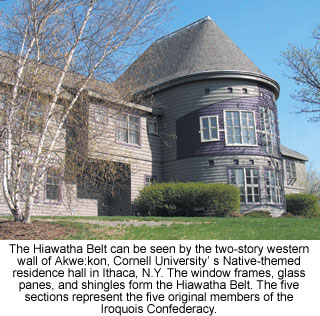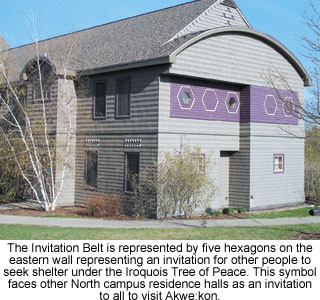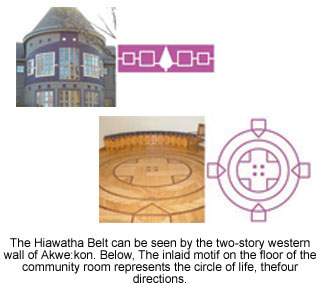 |
Canku Ota
|
 |
|
(Many Paths)
|
||
|
An Online Newsletter
Celebrating Native America
|
||
|
December 1, 2009 - Volume
7 Number 12
|
||
|
|
||
|
Cornell's Akwe:kon
Melds Learning With Dorm Living
|
||
|
by Babette Herrmann
- Indian Country Today correspondent
|
||
|
credits: Photos courtesy
Kakwireiosta Hall
|
|
The Mohawk name Akwe:kon translates to mean "all of us," as all Cornell students interested in Native culture are encouraged to apply for residency. Out of the 35 students staying in the co-ed dormitory, about half are Native, said Kakwireiosta Hall, residence hall director. The Invitation Belt is represented by five hexagons on the eastern wall representing an invitation for other people to seek shelter under the Iroquois Tree of Peace. This symbol faces other North campus residence halls as an invitation to all to visit Akwe:kon. Even though the number of students seems meager for a residence hall, Hall said this allows the students to form strong bonds, and essentially function like a family. There are two guest rooms available for visiting family, guests and prospective students. Non-residents can apply to become non-residential members, free of charge. "It enables a lot more people to be involved, and broadens our community in a really nice way," Hall said. Every element of Akwe:kon, from the architecture down to the furniture, was planned to represent Native culture and to honor the territory of the Cayuga people. The building was erected in the shape of an eagle with its wings stretched north and south, symbolizing watchful protection. Wampum belts featured on the exterior of the building honor the history of the Haudenosaunee people, some representing treaties and agreements.
"They are all unifying, and represent people working together in peace and friendship," Hall said. The Hiawatha Belt can be seen by the two-story western wall of Akwe:kon. Below, The inlaid motif on the floor of the community room represents the circle of life, thefour directions. And no attention to detail was skipped on the layout of the interior. The design of the wooden-barrel vaulted ceiling was inspired by the Haudenosaunee longhouse, a multi-family home. The multi-family concept parallels the multi-cultural and family oriented philosophy of students residing at Akwe:kon. Students are expected to behave respectfully during their stay in the dorms. Culturally stimulating activities are planned throughout the year, and there is a strict no alcohol and smoking policy. The Ongwe Hall Council meets regularly to plan activities, which can be as simple as gathering to watch a film or planning a discussion among peers on topics such as Native identity. Other activities are designed to teach students traditional crafts. Native artisans come to the hall to hold workshops in beading, sewing and making cornhusk dolls. Each spring, the students engage in an annual frybread competition; the winner gets their name displayed on a wall.
In April, residents help set up Cornell's annual powwow and smoke dance, but this year they dropped the powwow due to the high expense, and are holding a smoke dance only. Students also travel off campus to attend cultural activities in the area, especially to the nearby Cayuga Nation. Additionally, many students give back to the community by volunteering once a week to tutor Native students through the AIP Tutoring Program at LaFayette High School in LaFayette, N.Y. "It's very meaningful and a lot of great relationships have come out of that through mentoring or simple friendship," Hall said. These students represent each of the six Nations within the Haudenosaunee (Iroquois) Confederacy represented in the student body at Cornell University, Ithaca, N.Y. The students are positioned on the rocks respective to their geographical locations (left to right – west to east). The rocks are positioned outside Akwe:kon, Cornell's Native- themed residence hall. The activities are especially meaningful to residents who came to Akwe:kon knowing little, if anything about their Native heritage.
"That's the best part of living in the program." Jacqueline Blas, 20, came to live in the hall during her sophomore year. Now a senior, she learned about the house through her friends, and soon fell in love with the ambiance and people. Blas, a human development major, is currently one of two resident advisors. "I actually love living here, and have a lot of friends living here," she said. "I would say it's the most beautiful dorm on campus." AIP offers a minor and graduate minor in American Indian Studies. |
|
|
||
|
|
||
| Canku Ota is a free Newsletter celebrating Native America, its traditions and accomplishments . We do not provide subscriber or visitor names to anyone. Some articles presented in Canku Ota may contain copyright material. We have received appropriate permissions for republishing any articles. Material appearing here is distributed without profit or monetary gain to those who have expressed an interest. This is in accordance with Title 17 U.S.C. Section 107. | ||
|
Canku Ota is a copyright ©
2000, 2001, 2002, 2003, 2004, 2005, 2006, 2007, 2008, 2009 of Vicki
Barry and Paul Barry.
|
||
 |
 |
|
|
The "Canku
Ota - A Newsletter Celebrating Native America" web site and
its design is the
|
||
|
Copyright ©
1999, 2000, 2001, 2002, 2003, 2004, 2005,
2006, 2007, 2008, 2009 of Paul
C. Barry.
|
||
|
All Rights Reserved.
|
||
 ITHACA,
N.Y. – Cornell University made a progressive move when they
built the first Native-themed residence hall, Akwe:kon, pronounced
"a-gway-go," nearly 20 years ago. It was built to honor
the Haudenosaunee people, also known as the Six Nations of Iroquois,
and a collaborative effort between the university and the American
Indian Program.
ITHACA,
N.Y. – Cornell University made a progressive move when they
built the first Native-themed residence hall, Akwe:kon, pronounced
"a-gway-go," nearly 20 years ago. It was built to honor
the Haudenosaunee people, also known as the Six Nations of Iroquois,
and a collaborative effort between the university and the American
Indian Program.  For
example, the Hiawatha Belt, located on the second story of the western
side of the building, may look like a large dark purple border surrounding
the five windows on the rotunda. But the five windows represent
the five original members of the Iroquois Confederacy – the
Onondaga, Mohawk, Seneca, Oneida and Cayuga – and the story
runs much deeper, as do the stories behind all the wampum belts.
For
example, the Hiawatha Belt, located on the second story of the western
side of the building, may look like a large dark purple border surrounding
the five windows on the rotunda. But the five windows represent
the five original members of the Iroquois Confederacy – the
Onondaga, Mohawk, Seneca, Oneida and Cayuga – and the story
runs much deeper, as do the stories behind all the wampum belts. Students
regularly collaborate to sew traditional ribbon shirts and dresses
for powwows and ceremonies. "It's been personally one
of my favorites," Hall said. "It's about becoming
culturally self-sufficient."
Students
regularly collaborate to sew traditional ribbon shirts and dresses
for powwows and ceremonies. "It's been personally one
of my favorites," Hall said. "It's about becoming
culturally self-sufficient." Fred
Gonzales, 21, a human biology major and descendent of the Picuris
Pueblo, said he grew up knowing little about Native culture. As
a freshman, he was placed in Akwe:kon not by choice, but by happenstance.
This coincidence turned out to be a blessing in disguise, and for
two years he enjoyed the closeness of the small cohort.
Fred
Gonzales, 21, a human biology major and descendent of the Picuris
Pueblo, said he grew up knowing little about Native culture. As
a freshman, he was placed in Akwe:kon not by choice, but by happenstance.
This coincidence turned out to be a blessing in disguise, and for
two years he enjoyed the closeness of the small cohort.